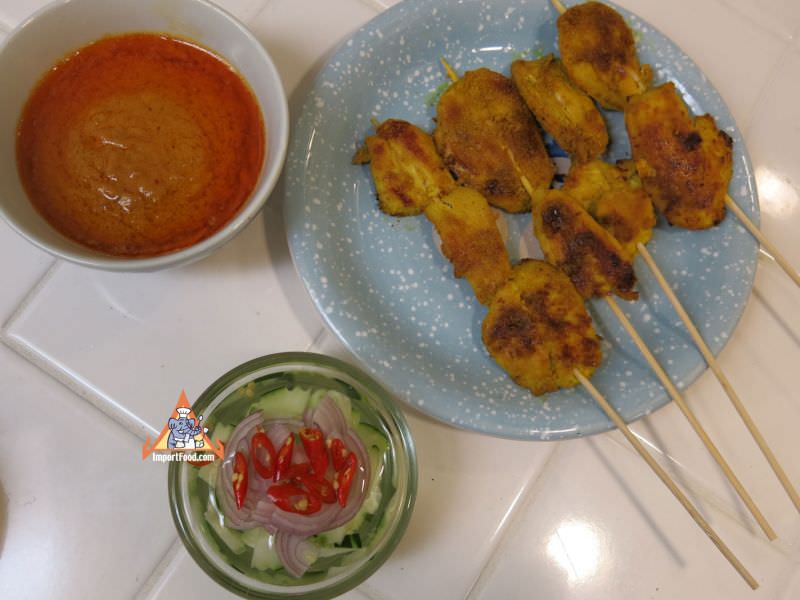Chicken Satay, 'Satay Gai'
Satay of course is originally an Indonesian/Malay dish, but it has been in Southern Thailand for a very long time.
Here we demonstrate two versions, Version 1 is our favorite and one you can make in your kitchen without a charcoal grill. The chicken in both versions is prepared as you'd find in Thailand -- using thin strips, instead of thick cuts that restaurants outside of Thailand often serve for satay.
For a quick satay we suggest our Lobo Thailand's ready-made package.
You can of course also make the same recipe as beef satay, pork satay, or prawn satay (large prawns usually deheaded and the skewer threaded lengthwise down the body).
Ingredients
For 4 Person(s)
Marinade Ingredients Version 1
- 1 Pound Chicken Breast, cut into thin pieces 2 - 3 inches long
- 1 Cup Coconut Milk
- 1 Teaspoon Turmeric Powder
- 1 Tablespoon Sugar
- 1 1/2 Tablespoons Thin Soy Sauce
Nam jim satay Peanut Sauce Ingredients Version 1
- 1 Tablespoon Red Curry Paste
- 1/4 Cup Fried Red Onion
- 1/2 Teaspoon Extra-Fine Ground Chile powder
- 1/4 Cup Roasted Peanut
- 1 1/2 Cups Coconut Milk
- 2 1/2 Tablespoons Palm Sugar
- 1 Tablespoon Tamarind Concentrate mixed w/1 TBSP Water
Marinade Ingredients Version 2
- 1 Teaspoon Coriander Seed
- 1 Teaspoon Cumin Seed
- 1 Tablespoon Chopped Garlic
- 1 Tablespoon Fresh Grated Ginger
- 1 Pound Chicken Breasts, Skinned, boned, and cut into bite sized pieces.
- 2 Tablespoons Fish Sauce
- 1 Tablespoon Curry Powder
- Pinch Turmeric Powder (as only a colorant, so very little!)
- 8 Tablespoons Coconut Milk
- 3 Tablespoons Palm Sugar
Nam jim satay Peanut Sauce Ingredients Version 2
- 4 Ounces Roasted (unsalted) Peanuts
- 4 Cloves Garlic, Chopped
- 1 Ounce Chopped Onion
- 1 1/2 Tablespoon Red or Massaman Curry paste
- 1 Teaspoon Fish Sauce
- 8 Tablespoons Coconut Milk
- 6 Teaspoons Lime Juice (to taste)
- 2 1/2 Teaspoons Palm Sugar
Ingredients For A jad cucumber sauce
- 8 Tablespoons White Vinegar
- 2 Teaspoons Sugar
- 2 1/2 Tablespoons Cucumber, Very Coarsely chopped or sliced
- 2 Shallots (or any variety of purple onion) Chopped
- 8 Fresh Thai Chiles
Method for Chicken Satay, 'Satay Gai'
Marinade Method - Version 1
Mix coconut milk, turmeric powder, sugar and soy sauce in a bowl, add chicken, marinade for 1 hour. You can thread the chicken onto satay sticks now, or cook the chicken first and thread it onto the sticks later (as we did). Cook the chicken over low heat, using all the marinade to baste as it cooks.
Peanut Sauce Method - Version 1
Pound the fried red onion in a mortar and pestle, set aside. Pound peanuts in a mortar and pestle, and set aside.
In a saucepan, heat 1 tablespoon vegetable oil, and fry red curry paste together with the pounded red onion and chile powder over medium heat, until fragrant. Add peanut, palm sugar, tamarind, salt, and stir. Add coconut milk, reduce heat, and keep at a high simmer until oil rises (this oil comes from the coconut milk, and it will look distinctive as shown in photo).
Serve as shown, with chicken on skewers accompanied by a bowl of satay sauce, and a bowl of ajad (see below).
Marinade Method - Version 2
Beat the chicken flat, using the flat of the blade of a heavy cleaver or a meat tenderizing mallet. You can also use a rolling pin.
The coriander and cumin are toasted then crushed in a mortar and pestle. The ingredients are then combined to form a marinade, and the chicken is marinated overnight. The pieces of chicken are then threaded on the satay sticks, loosely folding them in half and piercing through the folded meat to form a loose gather.
The completed sticks are then grilled, broiled or barbequed on fairly high heat (they taste best done over charcoal, as they absorb the smoke). Turn them regularly and brush them liberally with the remaining marinade. Cooking should take between 5 and 10 minutes depending on the heat of your cooker.
Peanut Sauce Method - Version 2
First grind or crush the peanuts to a fairly fine powder. Then combine them with the remaining ingredients (except the lime juice), to form a smooth sauce. If the sauce is too thick, you can thin it with a littlechicken stock. Now add the lime juice, tasting as you progress to check the balance of flavors is correct.
Note use red curry paste with beef or pork satay, massaman (as above) with chicken. If you are doing shrimp satay then use half the quantity of massaman paste.
A Jad Sauce
Combine the ingredients, and leave to stand overnight. Alternatively, you can gently heat the vinegar, add 4 tablespoons water, let it cool, then pour that over the other ingredients and serve right away.
Each diner should have a small bowl of nam jim and a small bowl of a jad. However the satay themselves are normally served "communally". We like to eat steamed jasmine rice that has a few spoonfulls of the Peanut Sauce on top.
